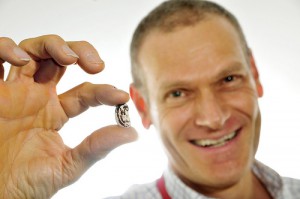- Celebrating the Irish Seed Savers Association celebrations. We had wanted to be there…
- CAS-IP on how to “break” the Plumpy’nut patent.
- Cattle wild relative seen for first time in 10 years. Well, by scientists anyway.
- “Initiatives that merely codify cultural products without taking the social-organizational context into account risk becoming little more than ‘museums of production.'” Ouch.
- Millet domestication pushed back in time.
- Antioxidant properties of traditional wild Iberian leafy greens. Yes, I know, this medicalizes nutrition, but I thought it was interesting that these wild species are still used.
- “…a trait of the diploid species, which apparently looks undesirable, might in fact be highly valuable for the improvement of amphidiploids…”
- “Food? We don’t need no stinkin’ food,” say UN negotiators.
- UK ambassador’s observations on agriculture in Ukraine. Love the contrast between 100 ha fields of sunflowers and the table groaning under home-grown fruit and vegetables.
- In other news, the UK’s ambassador to Ukraine has a blog. And so do a number of others. Sorely tempted to subscribe to their RSS.
Nibbles: Dingo, In vitro, Human diseases, Aphandra natalia, Cave fish, Pets, Pavlovsk, Elderberry, Urban ag, Chilies
- Aussies in a fluster about saving the dingo.
- Malaysia conserves a bunch of things in vitro.
- Cities good for TB resistance.
- Peruvian palm has 17 different uses.
- Mexican ceremony drives fish evolution.
- Today’s thing-that-made-us-human is: pets.
- Today’s new take on Pavlovsk: literature.
- Domestication in action: Elderberry improved.
- Urban ag in context, from Liverpool to Lagos.
- Pepper cultivation driven my masochism.
Nibbles: Kew, Diversity, Allanblackia and Acacia, Pulses, GIS, Poverty, Early morning flowering, Agrobiodiversity and climate change, Breeding, Genebanks, Perenniality, Blogs, AGRA, Potato diversity, Witchweed, Mexican potatoes, Salvia, Old Sicilian chestnut, Tropical maize
- Guardian has whole piece on the importance on Kew’s collections without once mentioning Millennium Seed Bank. Anyway, the Paris herbarium is not so bad either, though they are no match for the Kew press machine.
- Hybridization is good for plant diversity. Well, yeah. What am I missing here? Oh and here’s more about things that maintain variation, and more still. You see what I did there?
- Allanblackia is the next big thing in agroforestry. Which probably means its name will soon be changed.
- Conclave meets to discuss
election of next Popepulse productivity. - Videos from Africa GIS week.
- Meeting to review 10 years of research on chronic poverty. Must have been deeply depressing.
- Helping rice to keep its cool. A crop wild relatives story.
- “The Ministry of Science and Technology should emphasize the need to undertake research programmes on unexplored and underutilized crops as these could constitute the genetic base for genes for improved nutritional quality of foods.” In India, that is.
- “We need to mine that diversity to provide genetic material in an adapted background more readily to be used by plant breeders.” From CIMMYT. How many times have I heard that? Here’s my problem: who will do it?
- That IRIN feature from a few days ago recycled with a new pic. Which is of a genebank not included in the list in the text. The person shown is my friend Dr Jean Hanson, recently retired head of the ILRI genebank.
- DIY perennial cereals.
- “Biodiversity scientists and agricultural scientists have tended to approach their interests in very different ways. I think there’s a lot we can learn from each other.” Wait, what?
- Another best biodiversity blogs list. Ahem.
- A “very clear action plan” for a ‘Green Revolution’ in Africa emerges from AGRA meeting. You will however look in vain for the details on the scidev.net piece.
- The last Inka treasure. Yep, the potato.
- Boffins find anti-Striga gene. No, not really, settle down.
- Rachel Laudan is really rude about Mexican potatoes.
- Cur moriatur homo cui salvia crescit in horto? Good question.
- Finding the 100-Horse Chestnut.
- Getting to grips with photoperiod sensitivity in maize.
Nibbles: Cattle nutrition, Maize, Freshwater biota, Modeling maize, Rice, Book, Veg, Urban ag
- Climate change ain’t going to be good for cattle.
- But will be fabulous for breeders of drought-resistant maize.
- A fifth of Africa’s freshwater plants and animals threatened. How many of these are important to local people’s nutrition and health? A lot, I bet.
- Just a couple guys, modeling the spread of maize genetic diversity in the Americas.
- Uganda turns to wild relatives for new rice varieties.
- Toward Sustainable Agricultural Systems in the 21st Century recognizes importance of agrobiodiversity. Good to know.
- New Agriculturalist revisits veg-garden-in-a-sack.
- FAO policy brief on urban agriculture.
Daniel Debouck honoured
Daniel Debouck, a world expert on Phaseolus and the manager of CIAT’s genebank, ((Which didn’t make this list yesterday, but should have.)) is to be awarded the Frank N. Meyer Medal for Plant Genetic Resources. This is well-deserved recognition of three decades of painstaking work on the conservation and use of agrobiodiversity. Daniel’s latest paper in on Lima beans.
